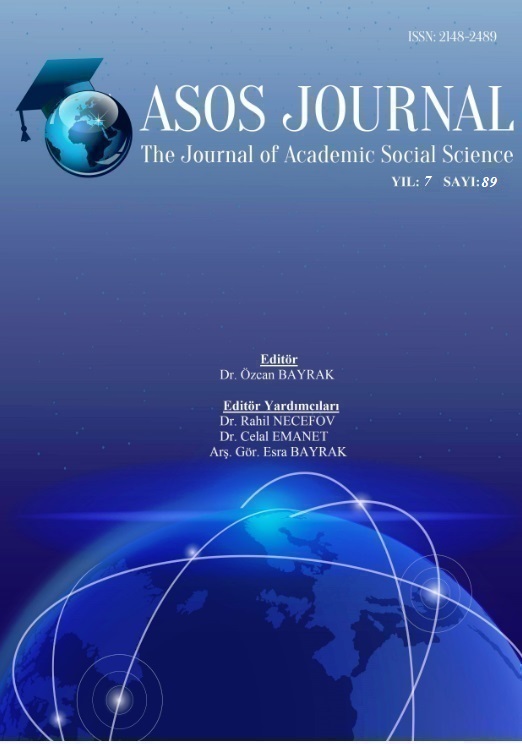Author :
Abstract
Ön-arka plan ilişkisi, dünyayı algılayış biçimimizi temelden etkileyerek her anımızda aktif bir rol üstlenir. Bir tasarım düşüncesinde de ön-arka plan ilişkisi, tasarıma yüklenen mesajı, tasarımın hedefini ve alıcıdaki sonuçlarını etkileyecek güçte bir ögedir. Bu doğrultuda çalışmamız, ön-arka plan ilişkisinin afiş tasarımındaki önemine odaklanmaktadır. Kimi zaman tek, kimi zaman da birden çok katmanlı yapıyla kurgulanan ön-arka plan ilişkisi, tasarımda uyumlu bir bütünlük taşımalıdır. Bu da ancak; tasarımın olanaklarında şekil, oran, boyut, hareket, perspektif, derinlik, denge, ritim, doku ve renk gibi pek çok kavram arasında saptanacak tutarlı ilişki-lerle sağlanabilir. Bu yüzden, tasarımcının ister tek ister çok katmanlı yapı içerisinde kurguladığı ön-arka plan ilişkisinde, hem tasarım hiyerarşisine hem de tasarımın ana fikrine daima sadık kalınmalıdır. Genel olarak afişin iki boyutlu düzlemi ön-arka plan ilişkisine göre harmanlanmaktadır. Tasarımın önemli yapı taşlarından biri olan ön-arka plan ilişkisi, aynı zamanda görsel bilginin in-şasına da yardımcı olmaktadır. Tasarımda öncelikle aktarmak istediğimiz bilgi ve mesajı özellikle bu yöntem üzerinden aktarırız. Bu yönüyle çalışmada, ön-arka plan ilişkisine bağlı olarak katmanlı yapının mesaja kattığı anlam örneklerle çözümlenmeye çalışılmıştır.
Keywords
Abstract
The front-back ground relationship has an active role in every moment of our lives influencing fundamentally the way we perceive the world. In a design idea, the front-back ground relationship is an influential element that can affect the message and the target of the design and the interpretations of the receiver. In this context, the study focuses on the importance of the front-back ground relationship in poster design. The front-back ground relationship, sometimes formed with a single and sometimes with multiple-layered structure, must be compatible in design. However, this compatibility can be provided by consistent relationships among the possibilities of design, shape, proportion, size, movement, perspective, depth, balance, rhythm, texture, and color. Therefore, in the front-back ground relationship that the designer forms in a single or multi-layered structure, it must always be adhered to the design hierarchy and the main idea of the design. In general, the two-dimensional plane of the poster is blended according to the front-back ground relationship. The front-back ground relationship which is one of the most important touchstones of design also helps in the construction of visual information. In the design, we primarily convey the information and message we want to transfer through this method. In this context, the aim and the focus of the study is to analyze the meaning of the layered structure depending on the front-back ground relationship by using examples.
Keywords
- Arbuzov, M . (2016). “Grafist 20”. Başak Ürkmez (Ed.). Maksim Arbuzov (ss.14-47) içinde. İstanbul: Mimar Sinan Güzel Sanatlar Üniversitesi Yayınları.
- Bektaş, D . (1992). Çağdaş Grafik Tasarımın Gelişimi. İstanbul: Yapı Kredi Yayınları.
- Çulha, D. & Türkmenoğlu, H. (2019). “Modern Sonrası Sanatta ve Grafik Tasarımda Zihinsel Tasarlanan Mekânlar”. Asos Journal Uluslararası Sosyal Bilimler Dergisi, 87, 126-143.
- Eagleman, D . (2011). Incognito - Beynin Gizli Hayatı. (Çev.: Zeynep Arık Tozar). İstanbul: Domingo Yayıncılık. (2013).
- Fletcher, A . (2001). “Grafist 5”. Esen Karol (Ed.). Alan Fletcher (ss.73-103) içinde. İstanbul: Mimar Sinan Güzel Sanatlar Üniversitesi Yayınları.
- Lee, D. H. (2007). Effective Use of Negative Space in Graphic Design. Rochester: Rochester Institute of Tecnology.
- Lehimler, Z. (2015). Afiş Tasarımında Optik Yanılsama. (Yayımlanmamış Sanatta Yeterlik Te- zi). İstanbul: Marmara Üniversitesi Güzel Sanatlar Enstitüsü.
- Ocvirk, O.G., Stinson, R.E., Wigg, P.R., Bone, R.O., & Cayton, D.L. (2013). Sanatın Temelleri: Teori ve Uygulama. (Çev.: Nur Balkır Kuru, Ali Kuru). İzmir: Karakalem Kitabevi Yayınları. (2015).
- Rifat, M. (2013). Açıklamalı Göstergebilim Sözlüğü. İstanbul: Türkiye İş Bankası Kültür Yayın- ları.
- Tepecik, A . (2002). Grafik Sanatlar tarih - tasarım - teknoloji. Ankara: Sistem Ofset Yayıncı- lık.
- Troxler, N . (2004). “Grafist 8”. T. Melih Görgün (Ed.). Niklaus Troxler (ss.104-121) içinde.
- Turgut, E . (2013). Grafik Dil ve Anlatım Biçimleri. Ankara: Anı Yayıncılık.
- Uçar, T. F. (2004). Görsel İletişim ve Grafik Tasarım. Ankara: İnkılâp Kitabevi.
- Weill, A. (2003). Grafik Tasarım. İstanbul: Yapı Kredi Yayınları. (2012).
- Görsel 1. Troxler, N. (Tasarımcı). (1980). Willisau Caz Festivali [Afiş tasarımı]. http://www.troxlerart.ch/details.php?bild_id=75&border=1 adresinden erişildi (ET: 26.06.2018)
- Görsel 2. Müller-Brockmann J. (Tasarımcı). (1960). Daha Az Gürültü [Afiş tasarımı]. https://www.moma.org/collection/works/7339 adresinden erişildi (ET: 21.06.2018)
- Görsel 3. Stenberg Kardeşler. (Tasarımcı). (1929). Kameralı Adam [Afiş tasarımı]. http://maeb- naeb-tab.blogspot.com/search/label/Daily%20Stenberg adresinden erişildi (ET: 21.06.2018)
- Görsel 4. Greiman, A. (Tasarımcı). (1987-1993). Pasifik Dalgası, AIGA [Afiş tasarımı]. https://stories.readymag.com/greiman/12/ adresinden erişildi (ET: 29.06.2018)
- şildi (ET: 27.06.2018)
- Görsel 6. Walsh, J. (Tasarımcı). (2012). Paylaşılan Sesler [Afiş tasarımı]. https://www.behance.net/gallery/4700315/Shared-Voices-Posters adresinden erişildi (ET: 22.06.2018)
- Görsel 7. Lehimler, Z. (Tasarımcı). (2018). a1. Performans, b1. Didem [Afiş tasarımı]. https://tr.pinterest.com/zaferlehimler/poster/ adresinden erişildi (ET: 23.06.2018)
- Görsel 8 Barcelo, Z. & Woodtli, M (Tasarımcı). (2018-2015). Langnau Caz Geceleri [Afiş tasa- rımı]. https://jazz-nights.ch/en/about-us/archives/programmarchiv/ adresinden erişildi (ET: 27.10.2018)
- Görsel 9. Erkmen, B. (Tasarımcı). (2018-2017-2016-2016-2015/2016-2015). Ariel Sanat Galeri- si [Afiş tasarımı]. http://bek.com.tr/ adresinden erişildi (ET: 24.12.2018)
- Görsel 10. Bankov, P. (Tasarımcı). (2018). 3. Moskova Uluslararası Deneysel Film Festivali [Afiş tasarımı]. http://bankovposters.com/works/posters/ adresinden erişildi (ET:





